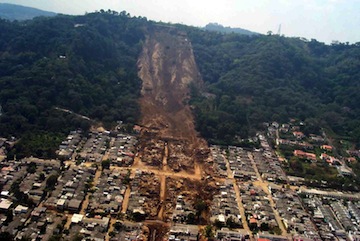360715-submarine landslide.jpg

Submarine landslides are similar to above ground landslides like this one in El Salvador. Credit: USGS
In November of 1929, a strong earthquake rattled the Atlantic Ocean south of Newfoundland. On shore, the quake knocked down a few chimneys and blocked some roads, but otherwise caused little damage on its own.
On the ocean floor, though, it triggered a giant landslide. Perhaps 50 cubic miles of sediments tumbled down the slopes, creating a tsunami. The waves soon crashed into Newfoundland and Nova Scotia, killing about 30 people and damaging or destroying dozens of villages.
Such giant submarine landslides aren’t all that common. But they can be set off by much more than earthquakes. A build-up of too much sediment, changes in ocean climate, or outbursts of gas from below the ocean floor can set the ground to moving. The resulting slides can whip along at highway speeds, and spread out across huge areas.
A landslide about 8,000 years ago off the coast of Norway, for example, stretched halfway to Greenland. And it carried enough material to cover present-day Texas with a layer of sediments as tall as a three-story building.
Another landslide took place about 18,000 years ago off the Atlantic coast of Virginia and North Carolina. It carried more than 30 cubic miles of material down the continental slope. Sonar observations show that it’s flanked by cracks in the edge of the continental shelf. Such cracks could weaken the shelf enough to spawn a new landslide — perhaps triggering a tsunami that could ravage a swatch of the Atlantic coast from North Carolina to Chesapeake Bay.

